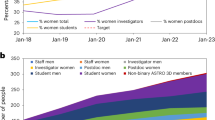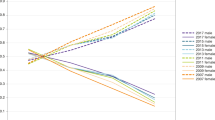Abstract
Striving for equality means striving for an equal, inclusive and diverse world. Gender is just one facet of the broader theme of diversity. Years of dedicated efforts to tackle gender equality in the workforce and throughout society in Europe show positive trends, but the timescales involved in implementing changes and making them effective means equality between women and men remains an important goal yet to be achieved by the majority of players (be these institutes, universities, research organizations or companies). This Perspective reports on the most recent initiatives in science and technology, with a special focus on the field of astronomy.
This is a preview of subscription content, access via your institution
Access options
Access Nature and 54 other Nature Portfolio journals
Get Nature+, our best-value online-access subscription
$29.99 / 30 days
cancel any time
Subscribe to this journal
Receive 12 digital issues and online access to articles
$119.00 per year
only $9.92 per issue
Buy this article
- Purchase on Springer Link
- Instant access to full article PDF
Prices may be subject to local taxes which are calculated during checkout

adapted from ref. 15, IAU

adapted from ref. 16, IAU
Similar content being viewed by others
Data Availability
The data shown in Fig. 1 are taken from the IAU and are publically available at https://www.iau.org/administration/membership/individual/distribution/. The data shown in Fig. 2 are taken from the Joint Global Survey of scientists, initiated by the project A Global Approach to the Gender Gap in Mathematical, Computing, and Natural Sciences: How to Measure It, How to Reduce It, a cross-disciplinary initiative sponsored by the International Science Council. So far, the data have been made available only among the project partners, and they will be published in the final report of the project (due January 2020).
References
Etzkowitz, H. & Ranga, M. Gender dynamics in science and technology: from the “leaky pipeline” to the “vanish box”. Brussels Econ. Rev. 54, 131–147 (2011).
Guarino, C. M. & Borden, V. M. H. Faculty service loads and gender: are women taking care of the academic family? Res. High. Educ. 58, 672–694 (2017).
Primas, F. Gender initiatives in astronomy. Nat. Astron. 2, 771–772 (2018).
Ivie, R. & Langer Tesfaye, C. Women in physics: a tale of limits. Phys. Today 65, 47–50 (2012).
Mihaljević-Brandt, H., Santamaría, L. & Tullney, M. The effect of gender in the publication patterns in mathematics. PLoS ONE 11, e0165367 (2017).
Primas, F. Status of women at ESO: a pilot study on ESO staff gender distribution. The Messenger 128, 67–71 (2007).
Gvozdanović, J. & Maes, K. Implicit Bias in Academia: A Challenge to the Meritocratic Principle and to Women’s Careers — And What to Do About It (LERU, 2018); https://go.nature.com/2IHkECe
Buitendijk, S. & Maes, K. Gendered Research and Innovation: Integrating Sex and Gender Analysis into the Research Process (LERU, 2015); https://go.nature.com/313d2At
Maes, K., Gvozdanović, J., Buitendijk, S., Ingalill Rahm, H. & Mantilleri, B. Women, Research and Universities: Excellence Without Gender Bias (LERU, 2012); https://go.nature.com/2VDIK66
Patat, F. Gender Systematics in Telescope Time Allocation at ESO. The Messenger 165, 2–9 (2016).
Reid, I. N. Gender-correlated systematics in HST proposal selection. Publ. Astron. Soc. Pac. 126, 923–934 (2014).
Reid, I. N. Hubble Cycle 26 TAC and anonymous peer review. Space Telescope Science Institute Newsletter (2018); https://go.nature.com/33uyQ9y
Patat, F., Kerzendorf, W., Bordelon, D., Van de Ven, G. & Pritchard, T. The distributed peer review experiment. The Messenger 177, 3–13 (2019).
Martell, R. F., Lane, D. M. & Emrich, C. Male-female differences: a computer simulation. Am. Psychol. 51, 157–158 (1996).
IAU Strategic Plan 2020–2030 (IAU, 2018); https://go.nature.com/2Wlbhxy
IAU Catalyst (IAU, June 2019); https://go.nature.com/2NkOYEf
Acknowledgements
The author thanks all of the colleagues with whom, over the past ten years, the author has exchanged views, engaged in stimulating discussions and attended or organized gender-related meetings and events.
Author information
Authors and Affiliations
Corresponding author
Ethics declarations
Competing interests
The author declares no competing interests.
Additional information
Publisher’s note Springer Nature remains neutral with regard to jurisdictional claims in published maps and institutional affiliations.
Rights and permissions
About this article
Cite this article
Primas, F. Promoting gender equality in the European astronomical community. Nat Astron 3, 1075–1079 (2019). https://doi.org/10.1038/s41550-019-0936-3
Received:
Accepted:
Published:
Issue Date:
DOI: https://doi.org/10.1038/s41550-019-0936-3
This article is cited by
-
Closing the gender gap in the Australian astronomy workforce
Nature Astronomy (2021)



